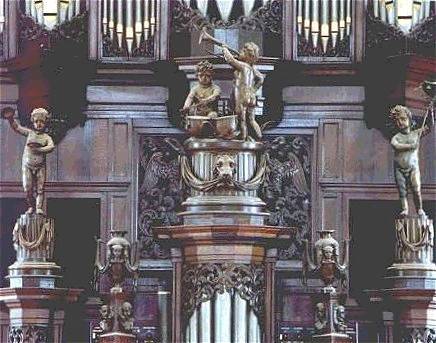Short history of the Der Aakerkorgan

statues atop the rugwerk
photograph Pieter A. Broere

statue atop the midtower
photograph Pieter A. Broere
1702 - 1977
The main organ of the Der Aa-Kerk in Groningen, in the opinion of many one of the most beautiful in the world, was built in 1702 by Arp Schnitger for the Academiekerk in the same city.
Its three manuals and pedals were moved to the present location by the organ builder Timpe in 1815, at which time chiefly cosmetic changes were made.
Among the changes are the statues atop the Hoofdwerk and Rugwerk cases.
Later, probably in 1830, Timpe removed Schnitger's Borstwerk and added a Bovenwerk.
In 1857 Petrus van Oeckelen, the most prominent organ builder in the area at that period, rebuilt the organ radically: he strengthened the lower pitches of the Pedaal and the Hoofdwerk, altered the mixtures to a lower pitch or removed them, altered reeds, removed the back wall of the Hoofdwerk case, made a new windchest (with full bass octave) for the Hoofdwerk and an additional Pedaal chest with full bass octave and registers at 16', 10 2/3', and 8' (Violoncel), new keyboards and action and new wind trunks, etc.
Since that time, only relatively insignificant changes have been made.
1977 - 1994
In 1977 Taylor & Boody dismantled the organ for safety during the restoration of the church building; it was later piously re-erected by the Dutch organ builder Reil.
From 1990 to 1996 regular concerts were again presented on the instrument.
The building and its furnishings are now the property of a private foundation dedicated to the preservation of historical monuments.
It is no longer used for church services.
[back][disposition]
